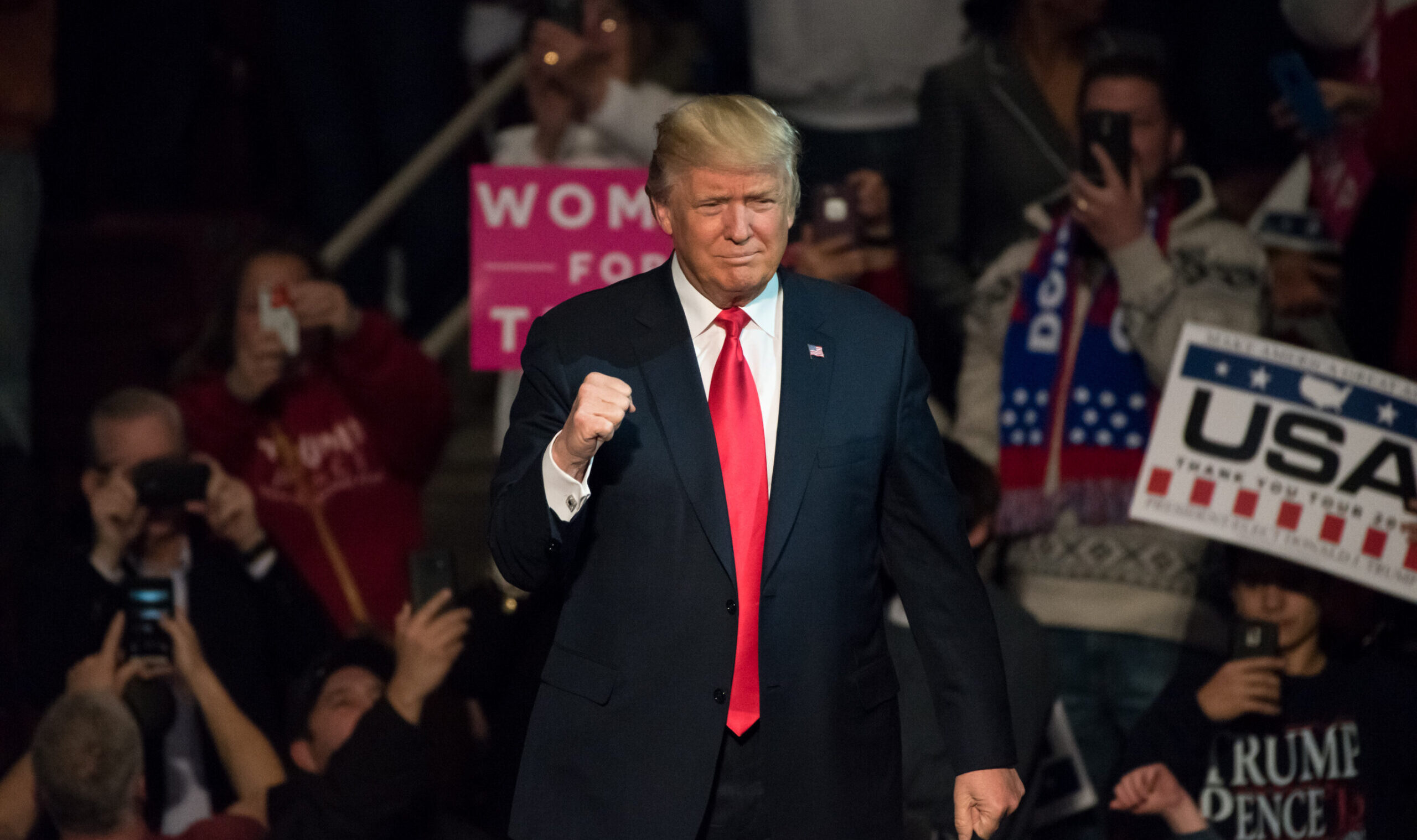Trump on Trump: The ‘First 100 Days’ Interviews
The president gave some of his clearest statements yet on foreign policy controversies.

President Donald Trump has given several recent interviews on his first 100 days in office. He first spoke with Time, then with The Atlantic, and, most recently, with NBC’s Meet the Press. In them, he gave some of his clearest statements yet on controversial foreign policy issues, though ambiguity on some important matters remained.
The Russia–Ukraine War
On the war in Ukraine that he promised to end on his first day in office, Trump made four bold statements. The first was on NATO membership for Ukraine, the second was on the role of NATO in provoking Russia’s invasion, the third was on territorial agreements, and the fourth was on America’s possibly walking away from negotiations.
On NATO membership, Trump reiterated the administration’s position that Ukraine would never join. When asked if Ukraine should “give up any hope of ever joining NATO,” he said, “I don’t think they’ll ever be able to join NATO.” The one-page peace plan that the U.S. presented to Ukraine in Paris on April 17 as America’s “final offer” firmly states that “Ukraine will not seek to join NATO.”
The second point that Trump made about NATO was that “what caused the war to start was when they [Ukraine] started talking about joining NATO.”
Talk of the war being provoked and Russia having legitimate security concerns has been heresy in the West. Yet it is a point that has been conceded by both Ukraine and NATO.
David Arakhamia, who led the Ukrainian negotiating team in the Belarus and Istanbul talks, confirmed that an assurance that Ukraine would not join NATO was the “key point” for Russia. According to Arakhamia, “They were prepared to end the war if we agreed to… neutrality and committed that we would not join NATO.” Zelensky himself said that the promise not to join NATO “was the first fundamental point for the Russian Federation” and that “as far as I remember, they started a war because of this.”
Jens Stoltenberg, who was then the secretary general of NATO, said that a NATO promise of no further enlargement “was a precondition” for Russia “not [to] invade Ukraine.” Putin, Stoltenberg said, “went to war to prevent NATO, more NATO, close to his borders.”
Trump’s answers to questions on territorial concessions were equally clear and important. Asked if Russia would keep Crimea, he answered concisely that “Crimea will stay with Russia.” Trump’s peace plan offers formal U.S. recognition of Russia’s ownership of Crimea and says the U.S. will de facto recognize that territory in the Donbas currently occupied by Russia is under “Russian control.”
Having stated what territory Ukraine will have to give up, Trump was asked what territory Russia would have to concede. Trump replied, “Russia will have to give up all of Ukraine. Because that’s what they want.” Trump then claimed that “if it weren’t for me, they would keep going” and that “they would be fighting right now for all of Ukraine.” Though the claim makes Ukraine’s loss of land more palatable for public consumption and credits Trump with having accomplished some tough negotiations, there is little to no evidence for his claim that Putin intended or intends to conquer all of Ukraine.
Trump and his team have repeatedly said in recent days that they could walk away from negotiations if a diplomatic solution seemed elusive. When an interviewer asked, “How long do you give both countries before you’re going to walk away?” Trump answered that “there will be a time when I will say, ‘Okay, keep going. Keep being stupid and keep fighting.’” Asked if he could envision “a situation in which you’re going to come in, not with troops, but with more weaponry, with full-blown support for Ukraine to keep its territorial integrity,” Trump downplayed a U.S. return to military support, saying that it “doesn’t have to be weapons. There are many forms of weapons. Doesn’t have to be weapons with bullets. It can be weapons with sanctions. It can be weapons with banking. It can be many other weapons.”
Trump was asked, “Is there anything that Putin could do that would cause you to say, ‘You know what? I’m on Zelensky’s side now.’” Taking the question to refer to Zelensky as a person and not as a representative of Ukraine, Trump revealingly replied, “Not necessarily on Zelensky’s side, but on Ukraine’s side, yes. Yeah. But not necessarily on Zelensky’s side. I’ve had a hard time with Zelensky.”
Nuclear Negotiations with Iran
On negotiating a nuclear deal with Iran, Trump continued to express optimism, but what that deal would entail underwent an important metamorphosis between his first interview with Time and his last interview with Meet the Press.
Trump continued to use his formulation that there are two ways to accomplish his goal of preventing Iran from acquiring a nuclear weapon (an ambition that Iran denies that it has). “I think we’re going to make a deal with Iran,” he said. But if “we can’t get a deal,” he said, he’d “very willingly” go to war with Iran. Trump insisted that “Iran will not have a nuclear weapon” but maintained that he “think[s] we can make a deal without the attack” and that he “would much prefer a deal than bombs being dropped.”
Trump has consistently said that negotiations with Iran over its nuclear program are limited to preventing Iran from developing a nuclear weapon: “You know, it’s not a complicated formula. Iran cannot have a nuclear weapon.” In the initial Time interview, he continued with the formulation that the goal of negotiations was verifiable limitations on Iran’s civilian nuclear program. “Iran will not have a nuclear weapon,” he said, simply.
But by the final interview with Meet the Press, Trump’s demand in negotiations seemingly had grown, though ambiguities in the White House’s official position remained. Asked “Is the goal of these talks limiting Iran’s nuclear program or total dismantlement?” Trump answered, “total dismantlement.”
Though Trump himself had always identified the goal of negotiations as being limited to preventing Iran from acquiring a nuclear weapon, then-National Security Advisor Mike Waltz has said that the U.S. is demanding “full dismantlement,” and Trump’s special envoy Steve Witkoff said that “a Trump deal” means “Iran must stop and eliminate its nuclear enrichment and weaponization program.”
In his interview with Meet the Press, Trump seemed to change his position and join Waltz and Witkoff in in their position that the U.S. is not negotiating verifiable limits on Iran’s civilian nuclear program but the “total dismantlement” of Iran’s nuclear program.
When the interviewer sought to clarify that “that’s all you’ll accept?” Trump confirmed, “yeah, that’s all I’d accept.” Trump rejected Iran’s need for a civilian nuclear program “to make electricity” because “they have so much oil, what do they need it for?”
Yet he then repeated his earlier stance that “the only thing they can’t have is a nuclear weapon.” He said, “I think that I would be open to hearing” about a civilian nuclear program to generate energy before seemingly shutting that option down again with the caution that “civilian energy often leads to military wars.”
Since the Meet the Press interview, Trump has said that he hasn’t decided if he’d accept a deal that allows Iran to develop civilian nuclear energy. If Trump’s final position is the hardline stance, it will complicate and possibly doom negotiations with Iran, whose team is negotiating under the firm limit imposed by Iran’s Supreme Leader Ayatollah Ali Khamenei that Iran will not negotiate “the full dismantling of Iran’s nuclear infrastructure.”
Territorial Expansion
Trump’s most worrisome comments pertained to the issue of U.S. territorial expansionism. When asked if he wanted “to be remembered as a president who expanded American territory,” Trump replied that he “wouldn’t mind.”
Trump made two bold statements on that matter. The first was on Canada, the second on Greenland.
Trump consistently reiterated his desire to annex Canada as the 51st state. He has regularly referred to the border that separates Canada and the U.S. as an “artificially drawn line.” Given the opportunity to retract the threat and clarify that the statements were intended, not as existential threats to Canada, but as part of a negotiating strategy, Trump passed on the opportunity and stated clearly for the record that he is serious.
“You’ve talked about acquiring Greenland, taking control of the Panama Canal, making Canada the 51st state,” the Time interviewer said. “Maybe you’re trolling a little bit on that one,” referring to Canada. “I’m really not trolling,” Trump insisted. Asked whether he planned on talking to Canada’s new Prime Minister, Mark Carney, about making Canada the fifty-first state at their first meeting, Trump said, “I’ll always talk about that.”
Trump also consistently claimed that Canada needs the United States, but the United States needs nothing from Canada. “We don’t need their gasoline; we don’t need their oil; we don’t need their lumber. We don’t need their energy of any type. We don’t need anything they have,” he said, before adding his solution to the asymmetrical relationship: “I say it would make a great 51st state.”
In the Meet the Press interview, Trump reiterated his claim that the U.S. doesn’t need anything from Canada before adding, “We do very little business with Canada. They do all of their business practically with us. They need us. We don’t need them.” Canada is actually the third largest exporter to the United States.
Perhaps Trump’s most alarming statement came after he repeated his desire to make Canada “a cherished state” and insisted that the border between the U.S. and Canada is an “artificial line that was drawn with a ruler many years ago.” He was asked, “Would you rule out military force to take Canada?” He answered, encouragingly, “Well, I think we’re not going to ever get to that point.… it’s highly unlikely. I don’t see it with Canada. I just don’t see it, I have to be honest with you.” He then, alarmingly, added, “It could happen. Something could happen with Greenland. I’ll be honest, we need that for national and international security.”
Trump then reminded his interviewer that when asking about his “desire to claim Canada [and] Greenland,” she “forgot the Panama Canal.”
These three “first 100 days” interviews provide clear insights into Trump’s foreign policy. Some of it is encouraging, some of it concerning, and all of it very controversial.
The post Trump on Trump: The ‘First 100 Days’ Interviews appeared first on The American Conservative.

